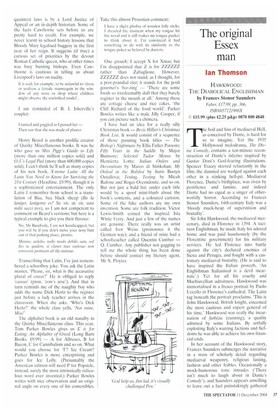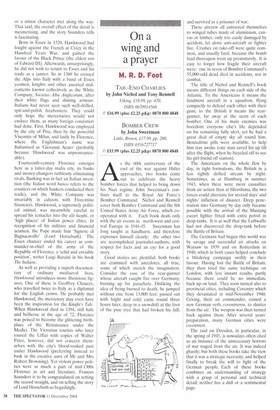The original Essex man
Ian Thomson
HAWKWOOD: THE DIABOLICAL ENGLISHMAN by Frances Stonor Saunders Faber, £17.99, pp. 366, ISBN057121908X
£15.99 (plus £2.25 p&p) 0870 800 4848 The boil and hiss of mediaeval Hell, as conceived by Dante, is hard for us to imagine. Yet the 1935 Hollywood melodrama, The Divine Comedy, contains a ten-minute reconstruction of Dante's inferno inspired by Gustav Dare's God-fearing illustrations. Spencer Tracey starred reluctantly in the film; the damned are wedged against each other in a stinking hell-pit. Mediaeval Florence, Dante's birthplace, was riven by pestilience and famine, and indeed Dante had no equal as a singer of otherworldly horror. According to Frances Stonor Saunders, 14th-century Italy was a 'bloody muck-heap of superstition and brutality'.
Sir John Hawkwood, the mediaeval mercenary, died in Florence in 1394. A taciturn Englishman, he made Italy his adored home and was paid handsomely (by the Florentine government) for his military services. He led Florence into battle against the city's declared enemies of Siena and Perugia, and fought with a customary mediaeval brutality. (He is said to have inspired the Italian proverb, 'An Englishman Italianised is a devil incarnate') Yet for all his cruelty and Machiavellian adroitness, Hawkwood was immortalised in a fresco portrait by Paolo Uccello in Florence's cathedral. The Latin tag beneath the portrait proclaims, 'This is John Hawkwood, British knight, esteemed the most cautious and expert general of his time.' Hawkwood was really the incarnation of furbizia (cunning), a quality admired by some Italians. By artfully exploiting Italy's warring factions and fiefdoms he was able to achieve his own financial ends.
In her account of the Hawkwood story, Frances Saunders submerges the narrative in a mass of scholarly detail regarding mediaeval weaponry, religious fasting, fashion and other foibles. Occasionally a mock-humorous tone intrudes (There isn't much to laugh about in Dante's Comedy'), and Saunders appears unwilling to leave out a fact painstakingly gathered
or a minor character met along the way. That said, the overall effect of the detail is mesmerising, and the story Saunders tells is fascinating.
Born in Essex in 1320, Hawkwood had fought against the French at Crecy in the Hundred Years War, and gained the favour of the Black Prince (the eldest son of Edward III). Afterwards, unsurprisingly, he did not wish to return to Essex and his trade as a tanner. So in 1360 he crossed the Alps into Italy with a band of Essex yeomen, knights and other assorted malcontents known collectively as the White Company, Societas Alba Anglicorum, after their white flags and shining armour. Italians had never seen such well-drilled, spit-and-polish freebooters. They could only hope the mercenaries would not enslave them, as many foreign condottieti had done. First, Hawkwood was employed by the city of Pisa, then by the powerful Viscontis of Milan, and lastly by Florence, where the Englishman's name was Italianised as 'Giovanni Acuto' (probably because 'Hawkwood' was unpronounceable).
Fourteenth-century Florence emerges here as a latter-day mafia city, its banks and money-changers ruthlessly eliminating rivals. Banking was in fact an Italian invention (the Italian word banco refers to the counters on which bankers conducted their trade), and the White Company was invariably in cahoots with Florentine financiers. Hawkwood, a supremely political animal, was meanwhile careful to spread his tentacles into the alti luoghi, or 'high places' of Italian power elites. In recognition of his military and financial acumen, the Pope made him 'Signore di Bagnacavallo' (Lord Horsebath). The Essex chancer ended his career as commander-in-chief of the army of the Republic of Florence, a 'solid and enviable position', writes Luigi Barzini in his book The Italians.
As well as providing a superb documentary of ordinary mediaeval lives, Hawkwood introduces more illustrious figures. One of these is Geoffrey Chaucer, who travelled twice to Italy as a diplomat for the English crown. He probably met Hawkwood; the mercenary may even have been the inspiration for the Knight's Tale. When Hawkwood died in 1394, still hale and bellicose at the age of 72, Florence was poised to become the glittering birthplace of the Renaissance under the Medici. The Victorian tourists who later toured the Uffizi with copies of Walter Pater, however, did not concern themselves with the city's blood-soaked past under Hawkwood (preferring instead to bask in the creative aura of Mr and Mrs Robert Browning). Yet violent power politics were as much a part of mid-1300s Florence as art and literature. Frances Saunders is to be congratulated on setting the record straight, and on telling the story of Lord Horsebath so beguilingly.











































































 Previous page
Previous page